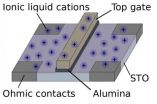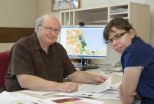(Press-News.org) Truly two-dimensional objects are rare. Even a thin piece of paper is trillions of atoms thick. When physicists do succeed in producing 2D systems, quantum interactions can lead to new phenomena and Nobel prizes. Two examples: graphene---single-atom-thick sheets of carbon atoms---has unique mechanical, electrical, and optical properties; and two-dimensional electron gases (2DEG)---planar collections of electrons supported at the interface between certain semiconductors such as gallium arsenide---allow the observation of such emergent behaviors as the quantum Hall effect and the spin Hall effect.
A relatively new frontier for studying 2D matter is provided by planar collections of electrons at the surface of transition-metal-oxide (TMO) materials, in which high electron densities give rise to interactions that are stronger than in semiconductors. Consequently it is more accurate to refer to the TMO electron ensemble as a 2D liquid rather than as a 2D gas. Scientists hope to find exotic emergent phenomena in these high-density, highly-interactive electron environments.
One of the leaders in this effort is James Williams, a new fellow at the Joint Quantum Institute (JQI), where he is also an assistant professor of physics at the University of Maryland. Before he left Stanford University, Williams and his colleagues performed tests on a thin sample of strontium titanate (STO) covered over with an electrolyte gel, a material in which negative and positive ions dissociate (saltwater is a common electrolyte: Na+ and Cl- ions come apart in a water solution). Their results appear in the journal Nature Physics. The article is accompanied by a "News and Views" essay recounting the highlights of the work.
The Experiment
Figure 1 shows the basic setup of the work conducted at Stanford. A thin STO panel, covered by a gate electrode down the middle, is wetted by an electrolyte gel. The negative ions in the electrolyte are drawn off by an unseen electrode and can be forgotten. Meanwhile the positive electrolyte ions settle down on the STO surface, where they induce a dense 2D layer of electrons to form directly beneath. The transport of these electrons as a current can be encouraged or discouraged by a voltage applied to an overlying electrostatic gate, pretty much the same arrangement used to move currents through field-effect-transistors (FETs), one of the universal components of myriad electronic devices. In effect, voltages applied at the 50-nm-wide gate region can create a barrier cutting off one portion of the material from the other or, conversely, offering a passage from the one side to the other.
Now is the time to mention that TMO materials are versatile. They can be insulating, conducting, semiconducting, superconducting and even show signs of ferromagnetism. Williams and his colleagues at Stanford and Santa Barbara were the first to discover that bulk strontium titanate (a common TMO) that was simultaneously superconducting and ferromagnetic. Furthermore, the same material can be tuned from one type of behavior to another, usually by changing the density of electrons in the sample.
In the present experiment, the interest is in seeing how normal and supercurrents flow through tiny channels from one superconducting STO panel to another through a narrow passage. The passage is so narrow -- comparable to the size of the electrons considered in their wavelike manifestation -- that quantum effects are expected to occur.
The size of the opening and the consequent flow of current through the barrier to the other side can be controlled by changing the gate voltage. At low voltages (and at densities of less than about 8 x 10^12 electrons per sq. centimeter) the barrier material remains an insulator. Little or no current flows. At medium voltage and density, some quantum tunneling proceeds; that is, some electron-pairs can leap to the other size. At higher voltage and at higher density (above 5 x 10^13 per/cm^2---a hundred times larger than is present in most FETs) tiny conducting zones can materialize. When some of these zones link to span the barrier, an effective channel allows superconducting currents to flow freely.
These little free-current gauntlets---called quantum point contacts---have been studied before, but not in strontium titanates. What justifies the use of the word quantum here is that the conductivity of the superconducting STO material is quantized. That is, the conductivity of Cooper pairs should only occur at certain levels, namely multiples of 2e^2/h, where e is the charge of an electron and h is Planck's constant.
But graphs of current versus gate voltage show that the conductivity (equal to the slope of the graph at any one voltage) can also occur at multiples of e^2/h. This suggests that the electrons flowing through the tiny passage have their spin degree of freedom broken, just as electrons in a ferromagnet don't have the freedom to point in any direction but are lined up in a coordinated way. The combination of the high electron density and potent electron interactions are not seen in other materials and the quantum regime enforced by the tight passageway, might here be engendering some new kind of electron transport.
As the electron density outside the quantum point contact is increased, the material becomes superconducting and the transmission of Cooper pairs – the particles that comprise a superconducting current – through the constriction was also studied in this work. But something is missing: Cooper pairs are made of pairs of electrons with opposite spins, yet in the constriction these two degrees of freedom are not available. How then, do Cooper pairs make it through the constriction? Could this particular TMO have Cooper pairs that don't get together in the conventional way?
Looking for Novel Forms of Superconductivity: P-Wave Versus S-Wave
Their new experimental results are reported online in the journal Nature Physics on August 31, 2014. The authors speculate that this behavior is consistent with (but not yet proof of) of novel superconductivity, one candidate of which is a p-wave superconductor . More research needs to be done before this speculation is given a strong footing. In conventional, or s-wave superconductivity, the pairs of electrons (Cooper pairs) that constitute a zero-resistance current, are spherical in shape. In p-wave superconductivity, the pairs would look more like miniature dumbbells festooned with additional lobes.
P-wave superconductivity has not been unambiguously seen yet since the anatomy of the electron pairs is difficult to establish. But the search has generated much interest. This is because theorists believe the p-wave materials could support the existence of Majorana particles (named for physicist Ettore Majorana), which are expected to have strange properties, such as being their own antiparticles.
INFORMATION:
"Gate-tunable superconducting weak link and quantum point contact spectroscopy on a strontium titanate surface," Patrick Gallagher, Menyoung Lee, James R. Williams, and David Goldhaber-Gordon, Nature Physics, published online 31 August 2014; http://www.nature.com/nphys/journal/vaop/ncurrent/full/nphys3049.html, doi:10.1038/nphys3049.
(2) http://www.nature.com/nphys/journal/vaop/ncurrent/full/nphys3098.html
James Williams
jwilliams@physics.umd.edu
Press contact at JQI
Phillip F. Schewe
pschewe@umd.edu
301-405-0989. http://jqi.umd.edu/
Two-dimensional electron liquids
Looking for novel forms of superconductivity
2014-09-09
ELSE PRESS RELEASES FROM THIS DATE:
Rice wireless experts tap unused TV spectrum
2014-09-09
Rice University wireless researchers have found a way to make the most of the unused UHF TV spectrum by serving up fat streams of data over wireless hotspots that could stretch for miles.
In a presentation today at the Association for Computing Machinery's MobiCom 2014 conference in Maui, Hawaii, researchers from Rice's Wireless Network Group will unveil a multiuser, multiantenna transmission scheme for UHF, a portion of the radio spectrum that is traditionally reserved for television broadcasts.
"The holy grail of wireless communications is to go both fast and far," ...
Globalization threatens benefits of an African 'green revolution'
2014-09-09
A prospective "green revolution" in Africa could boost land use and carbon emissions globally, according to a study co-authored by a University of British Columbia researcher.
The term "green revolution" typically describes the use of agricultural innovations – such as the development of new seeds – to increase yields, particularly in developing countries.
Past green revolutions in Asia, Latin America and the Middle East have spared land and carbon dioxide emissions. However, in an increasingly globalized economy, an African green revolution could lead to opposite outcomes, ...
This week from AGU: Global food trade, weather forecasting, aerosol transport
2014-09-09
From AGU's blogs: Global food trade may not meet all future demand, new study indicates
As the world population continues to grow, by about 1 billion people every 12 to 14 years since the 1960s, the global food supply may not meet escalating demand – particularly for agriculturally poor countries in arid to semi-arid regions, such as Africa's Sahel, that already depend on imports for much of their food supply, according to a new study published online in the American Geophysical Union journal, Earth's Future.
From this week's Eos: Next-Generation Forecasting of High-Impact ...
Kessler Foundation multiple sclerosis researchers find role for working memory in cognitive reserve
2014-09-09
West Orange, NJ. September 9, 2014. Kessler Foundation scientists have shown that working memory may be an underlying mechanism of cognitive reserve in multiple sclerosis (MS). This finding informs the relationships between working memory, intellectual enrichment (the proxy measure for cognitive reserve) and long-term memory in this population. "Working memory mediates the relationship between intellectual enrichment and long-term memory in multiple sclerosis: An exploratory analysis of cognitive reserve" (doi: 10.1017/S1355617714000630) was published online ahead of ...
Proactive office ergonomics can increase job satisfaction and employee retention
2014-09-09
As the amount of time employees spend at their desks increases, so does musculoskeletal discomfort and other health issues associated with the office environment. Although office ergonomics training programs have been shown to improve employee well-being and productivity, in many cases training occurs only after complaints are logged. New research to be presented at the HFES 2014 Annual Meeting in Chicago demonstrates that a comprehensive and proactive workplace ergonomics program can help to prevent discomfort and injury.
Alan Hedge, coauthor of "Proactive Office Ergonomics ...
New map tool identifies patterns of racial diversity across the US
2014-09-09
University of Cincinnati geography researchers have developed a large-scale mapping technique to track a variety of demographic data across the United States, including researching populations based on gender, race and economic diversity. Details on the technique behind the new, high resolution, grid-based map of U.S. demographics developed by Anna Dmowska, a postdoctoral fellow for UC's Space Informatics Lab, and Tomasz Stepinski, the Thomas Jefferson Chair Professor of Space Exploration at UC, are published in this month's issue of Applied Geography. The map can also ...
Gambling is just plain fun for those players who are in control
2014-09-09
People who are in control of their gambling habits play for fun and like the idea of possibly winning big. They set limits on how much money and time they can spend, and they are likely to gamble on the internet. But gambling is just one of several leisure activities these players undertake. In contrast, gambling is a form of escapism for problem players and often their only social activity, say Richard Wood of GamRes Ltd. in Canada, and Mark Griffiths of Nottingham Trent University in the UK. The results appear in Springer's Journal of Gambling Studies.
Their study is ...
1 in 5 young men unable to purchase emergency contraception
2014-09-09
September 9, 2014 -- Male shoppers in search of emergency contraception do not always have an easy time making these purchases and may be turned away at their local pharmacies. A "mystery shopper" survey conducted in New York City by researchers at Columbia University's Mailman School of Public Health and Columbia University Medical Center showed that males had a 20 percent likelihood of not being able to purchase emergency contraception. Nearly three-quarters of the pharmacies in the study created barriers for the males to get the contraception. This is the first research ...
Sickle cell patients who experience discrimination miss out on treatment
2014-09-09
Experiencing discrimination because of their race or health condition can influence just how much trust people put into the health profession. In fact, having these experiences was associated with a 53-percent increase in the chances that someone suffering from sickle cell disease will not follow their doctors' orders, says Carlton Haywood Jr. of the Berman Institute of Bioethics and the Johns Hopkins School of Medicine in the US. Haywood led a study appearing in The Journal of General Internal Medicine, published by Springer, into the experiences of how patients who suffer ...
National Renewable Energy Laboratory updates cetane data used for development of energy efficient fuels and engines
2014-09-09
The Energy Department's National Renewable Energy Laboratory (NREL) has released a long-anticipated update to the source-of-record for cetane number data. This information is vital to the development of new, energy-efficient, low-carbon fuels and compatible engines. Researchers, as well as members of the engine, vehicle, and fuel industries, rely on these numbers to target compounds for development of new fuels capable of greater energy efficiency, cleaner emissions, and maximum performance in diesel engines.
A cetane number is a relative ranking of fuels based on the ...
LAST 30 PRESS RELEASES:
Deep ocean earthquakes drive Southern Ocean’s massive phytoplankton blooms, study finds
Without campus leftovers to pick through, the beaks of this bird changed shape during the pandemic
High-dose antibiotic does not reduce mortality in tuberculous meningitis
How many insects fly in the sky above the USA?
Could cheese protect your brain health?
Who faces more difficulty recovering from stroke?
Colliding galaxies create the brightest, fastest growing black holes at their center
New BrainHealth research reveals tradeoffs on sleep with cannabis use for chronic pain
Aging-US now on ResearchGate, enhancing visibility for authors and readers
'Molecular glue' stabilizes protein that inhibits development of non-small cell lung cancer
Mount Sinai Health System is recognized in 2025 Chime Digital Health Most Wired survey
From prey to predator: How carnivores spread beneficial fungi
Menopause symptoms may be frequent and have negative effects, according to female endurance athletes
US Congressmembers’ responses on X to mass shooting events differ along party lines
KAIST-UEL team develops “origami” airless wheel to explore lunar caves
Individual genetic differences render some therapies ineffective
Engineering dendritic cells boosts cancer immunotherapy
Sophisticated neuroimaging reveals PTSD in WTC responders is linked to measurable physical changes in brain structure
Health policy experts identify promising strategies for providing health care to homeless people
Study explores role of neutrophils in canine atopic dermatitis
Mayo Clinic researchers develop AI-ECG model to diagnose liver disease earlier
Heavy menstruation common among teenage girls – questionnaire reveals risk of iron deficiency
New study explores why open water swimming feels so powerful for midlife women
In echo of Jurassic Park, mosquitoes capture entire ecosystems in their blood meals
Marty Cooper, Illinois Tech Alumnus and ‘Father of the Cell Phone,’ Receives 2025 Marconi Society Lifetime Achievement Award
How to reduce the risk of lymphedema
NEJM Evidence and CIDRAP announce Public Health Alerts
New fossil study illuminates on the evolutionary success of frogs
Patient-specific human liver model to understand disease mechanisms
Confused by the doctor's questionnaire? U of A study suggests it's common
[Press-News.org] Two-dimensional electron liquidsLooking for novel forms of superconductivity





